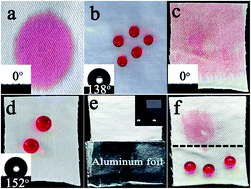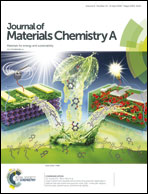Functionalization of cotton fabrics with highly durable polysiloxane–TiO2 hybrid layers: potential applications for photo-induced water–oil separation, UV shielding, and self-cleaning
Abstract
Using a facile strategy to prepare multifunctional cotton fabrics with switchable superhydrophobicity–superhydrophilicity, UV-resistance, photo-induced water–oil separation, and self-cleaning properties is an important and urgent issue in the sustainable development of natural fibers. Herein, a new type of surface modified cotton fabric with a polysiloxane–TiO2 hybridized coating (Cot-g-PMAPS/TiO2) was prepared through radiation-induced graft polymerization and sol–gel technology. The hybridized coating was composed of two sub-layers: an inner part consisting of an organic–inorganic hybrid layer to address the issue of self-degradation of TiO2-loaded polymeric materials while simultaneously improving the adhesion of the TiO2 film to its support, and an outer part consisting of nanocrystalline anatase TiO2 to endow the cotton fabric with multifunctionality. The influence of the polysiloxane–TiO2 on the structure and integrated performance of Cot-g-PMAPS/TiO2 was systematically studied. The results showed that the polysiloxane–TiO2 coating improved the UV absorption capacity 5.6-fold compared with that of the untreated cotton fabric. In addition, the retention of the break strength of Cot-g-PMAPS/TiO2 was 95.6% after 192 h of UV irradiation. Since the polysiloxane–TiO2 coating is chemically bound to the cotton fibers, the Cot-g-PMAPS/TiO2 fabric possesses long-term stability, ultra-high durability, and robustness. After 20 commercial or domestic launderings, the UV absorption intensity and WCAs were almost the same as those of the newly fabricated material. The Cot-g-PMAPS/TiO2 also exhibits photo-induced water–oil separation and self-cleaning based on the switchable superhydrophobicity–superhydrophilicity and the photoactivity of TiO2. This study provides an interesting insight into the design of a novel functional material based on a controllable surface structure.



 Please wait while we load your content...
Please wait while we load your content...